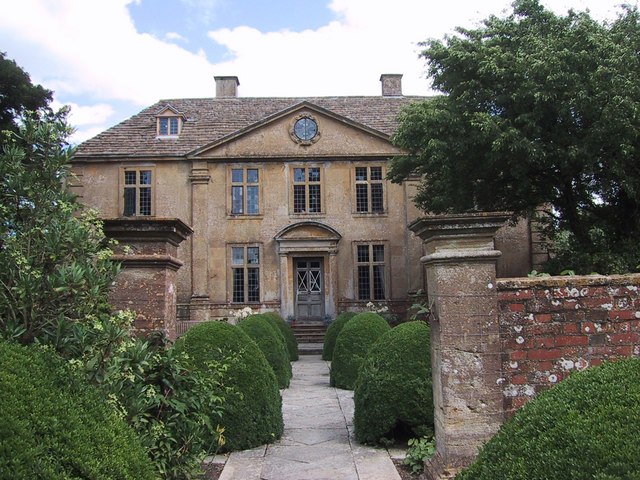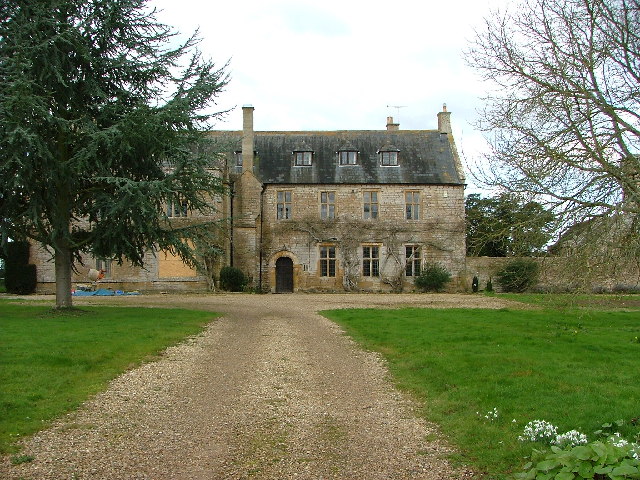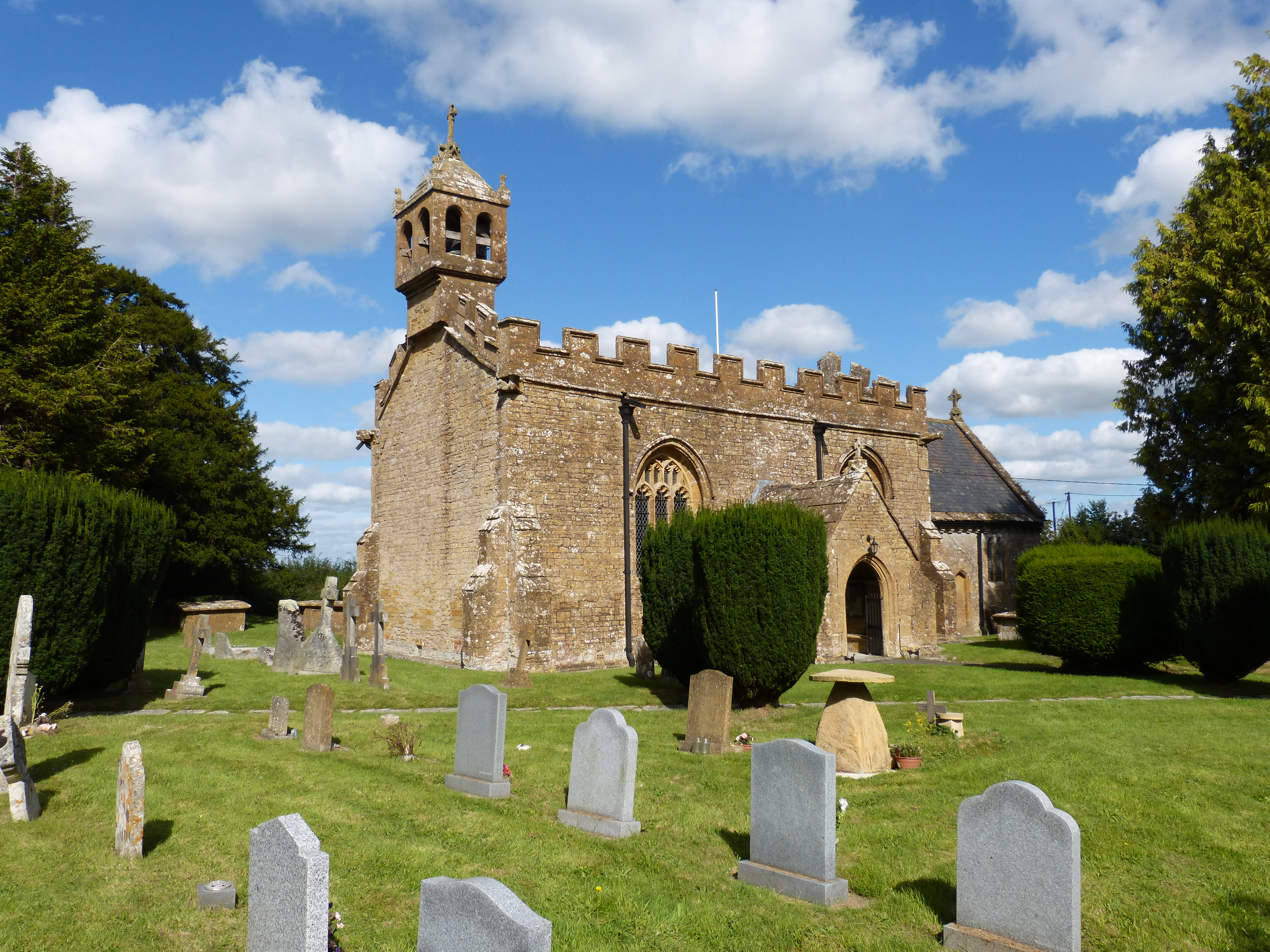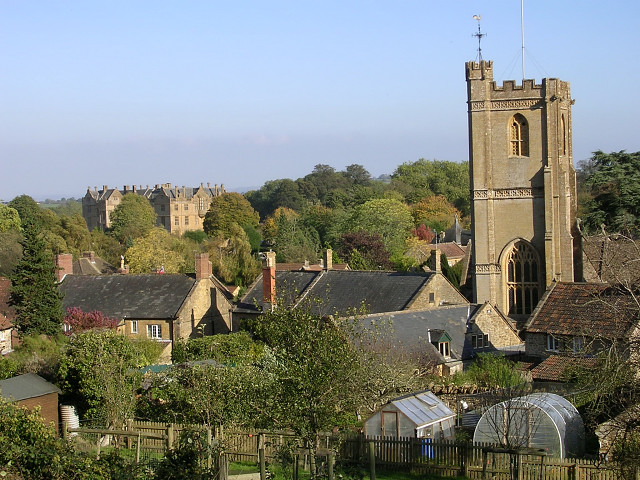Tintinhull House and Garden
Heritage Site in Somerset South Somerset
England
Tintinhull House and Garden
![Tintinhull House and Gardens [1] The west front of the house.
Tintinhull House and Gardens comprise a small 20th century garden surrounding a 17th-century house. The house was originally a small farmhouse built in 1630 and was enlarged circa 1722 and there are later additions. Constructed of parallel ranges of Ham stone ashlar under a stone slate roof. The house is owned by the National Trust and used as a holiday let. Listed, grade I, with details at: <span class="nowrap"><a title="https://historicengland.org.uk/listing/the-list/list-entry/1265231" rel="nofollow ugc noopener" href="https://historicengland.org.uk/listing/the-list/list-entry/1265231">Link</a><img style="margin-left:2px;" alt="External link" title="External link - shift click to open in new window" src="https://s1.geograph.org.uk/img/external.png" width="10" height="10"/></span>
The gardens were developed in the early 20th century and were expanded and planted between 1933 and 1961 and have continued to be developed. Owned by the National Trust, the gardens are open to the public and are on the Register of Historic Parks and Gardens, grade II, with much history and detail at: <span class="nowrap"><a title="https://historicengland.org.uk/listing/the-list/list-entry/1001156" rel="nofollow ugc noopener" href="https://historicengland.org.uk/listing/the-list/list-entry/1001156">Link</a><img style="margin-left:2px;" alt="External link" title="External link - shift click to open in new window" src="https://s1.geograph.org.uk/img/external.png" width="10" height="10"/></span>](https://s1.geograph.org.uk/geophotos/07/53/19/7531901_815bc4d8.jpg)
Tintinhull House and Garden, located in Somerset, England, is a stunning example of an early 17th-century manor house with a meticulously maintained garden. The house itself is a Grade I listed building, while the garden is a Grade II* listed site. It is managed by the National Trust and is open to the public.
The manor house, built in 1630, showcases the architectural style of the period, with its mellow Ham stone exterior and elegant windows. Inside, visitors can explore the beautifully furnished rooms, each displaying a mix of original features and period furniture. Notable highlights include the Great Hall, the Long Gallery, and the Tudor fireplace.
The garden at Tintinhull House is a true horticultural masterpiece. It was designed by Phyllis Reiss, a renowned garden designer, in the 20th century. The garden is divided into a series of "rooms," each with its own distinct character and planting style. Visitors can wander through the White Garden, the Pool Garden, the Cottage Garden, and the Rose Garden, among others, enjoying the vibrant colors and scents of the carefully chosen plants.
Tintinhull House and Garden also boast a picturesque orchard, a vegetable garden, and a tranquil pond. The garden is known for its impeccable maintenance and attention to detail, with well-manicured lawns, perfectly trimmed hedges, and an abundance of flowers throughout the seasons.
The site offers visitors an opportunity to step back in time and experience the beauty and tranquility of a traditional English manor house and its stunning gardens. It is a must-visit for history enthusiasts, garden lovers, and anyone seeking a peaceful escape in the heart of Somerset.
If you have any feedback on the listing, please let us know in the comments section below.
Tintinhull House and Garden Images
Images are sourced within 2km of 50.975/-2.711 or Grid Reference ST5019. Thanks to Geograph Open Source API. All images are credited.
![Tintinhull House and Gardens [1] The west front of the house.
Tintinhull House and Gardens comprise a small 20th century garden surrounding a 17th-century house. The house was originally a small farmhouse built in 1630 and was enlarged circa 1722 and there are later additions. Constructed of parallel ranges of Ham stone ashlar under a stone slate roof. The house is owned by the National Trust and used as a holiday let. Listed, grade I, with details at: <span class="nowrap"><a title="https://historicengland.org.uk/listing/the-list/list-entry/1265231" rel="nofollow ugc noopener" href="https://historicengland.org.uk/listing/the-list/list-entry/1265231">Link</a><img style="margin-left:2px;" alt="External link" title="External link - shift click to open in new window" src="https://s1.geograph.org.uk/img/external.png" width="10" height="10"/></span>
The gardens were developed in the early 20th century and were expanded and planted between 1933 and 1961 and have continued to be developed. Owned by the National Trust, the gardens are open to the public and are on the Register of Historic Parks and Gardens, grade II, with much history and detail at: <span class="nowrap"><a title="https://historicengland.org.uk/listing/the-list/list-entry/1001156" rel="nofollow ugc noopener" href="https://historicengland.org.uk/listing/the-list/list-entry/1001156">Link</a><img style="margin-left:2px;" alt="External link" title="External link - shift click to open in new window" src="https://s1.geograph.org.uk/img/external.png" width="10" height="10"/></span>](https://s1.geograph.org.uk/geophotos/07/53/19/7531901_815bc4d8.jpg)
![Tintinhull House and Gardens [2] The west front of the house.
Tintinhull House and Gardens comprise a small 20th century garden surrounding a 17th-century house. The house was originally a small farmhouse built in 1630 and was enlarged circa 1722 and there are later additions. Constructed of parallel ranges of Ham stone ashlar under a stone slate roof. The house is owned by the National Trust and used as a holiday let. Listed, grade I, with details at: <span class="nowrap"><a title="https://historicengland.org.uk/listing/the-list/list-entry/1265231" rel="nofollow ugc noopener" href="https://historicengland.org.uk/listing/the-list/list-entry/1265231">Link</a><img style="margin-left:2px;" alt="External link" title="External link - shift click to open in new window" src="https://s1.geograph.org.uk/img/external.png" width="10" height="10"/></span>
The gardens were developed in the early 20th century and were expanded and planted between 1933 and 1961 and have continued to be developed. Owned by the National Trust, the gardens are open to the public and are on the Register of Historic Parks and Gardens, grade II, with much history and detail at: <span class="nowrap"><a title="https://historicengland.org.uk/listing/the-list/list-entry/1001156" rel="nofollow ugc noopener" href="https://historicengland.org.uk/listing/the-list/list-entry/1001156">Link</a><img style="margin-left:2px;" alt="External link" title="External link - shift click to open in new window" src="https://s1.geograph.org.uk/img/external.png" width="10" height="10"/></span>](https://s0.geograph.org.uk/geophotos/07/53/19/7531904_0884e80d.jpg)
![Tintinhull House and Gardens [3] The round pond in the Fountain Garden.
Tintinhull House and Gardens comprise a small 20th century garden surrounding a 17th-century house. The house was originally a small farmhouse built in 1630 and was enlarged circa 1722 and there are later additions. Constructed of parallel ranges of Ham stone ashlar under a stone slate roof. The house is owned by the National Trust and used as a holiday let. Listed, grade I, with details at: <span class="nowrap"><a title="https://historicengland.org.uk/listing/the-list/list-entry/1265231" rel="nofollow ugc noopener" href="https://historicengland.org.uk/listing/the-list/list-entry/1265231">Link</a><img style="margin-left:2px;" alt="External link" title="External link - shift click to open in new window" src="https://s1.geograph.org.uk/img/external.png" width="10" height="10"/></span>
The gardens were developed in the early 20th century and were expanded and planted between 1933 and 1961 and have continued to be developed. Owned by the National Trust, the gardens are open to the public and are on the Register of Historic Parks and Gardens, grade II, with much history and detail at: <span class="nowrap"><a title="https://historicengland.org.uk/listing/the-list/list-entry/1001156" rel="nofollow ugc noopener" href="https://historicengland.org.uk/listing/the-list/list-entry/1001156">Link</a><img style="margin-left:2px;" alt="External link" title="External link - shift click to open in new window" src="https://s1.geograph.org.uk/img/external.png" width="10" height="10"/></span>](https://s2.geograph.org.uk/geophotos/07/53/19/7531910_abbf679d.jpg)
![Tintinhull House and Gardens [4] The long pond in the Pool Garden.
Tintinhull House and Gardens comprise a small 20th century garden surrounding a 17th-century house. The house was originally a small farmhouse built in 1630 and was enlarged circa 1722 and there are later additions. Constructed of parallel ranges of Ham stone ashlar under a stone slate roof. The house is owned by the National Trust and used as a holiday let. Listed, grade I, with details at: <span class="nowrap"><a title="https://historicengland.org.uk/listing/the-list/list-entry/1265231" rel="nofollow ugc noopener" href="https://historicengland.org.uk/listing/the-list/list-entry/1265231">Link</a><img style="margin-left:2px;" alt="External link" title="External link - shift click to open in new window" src="https://s1.geograph.org.uk/img/external.png" width="10" height="10"/></span>
The gardens were developed in the early 20th century and were expanded and planted between 1933 and 1961 and have continued to be developed. Owned by the National Trust, the gardens are open to the public and are on the Register of Historic Parks and Gardens, grade II, with much history and detail at: <span class="nowrap"><a title="https://historicengland.org.uk/listing/the-list/list-entry/1001156" rel="nofollow ugc noopener" href="https://historicengland.org.uk/listing/the-list/list-entry/1001156">Link</a><img style="margin-left:2px;" alt="External link" title="External link - shift click to open in new window" src="https://s1.geograph.org.uk/img/external.png" width="10" height="10"/></span>](https://s0.geograph.org.uk/geophotos/07/53/19/7531912_5a9b0e6c.jpg)
![Tintinhull House and Gardens [5] A small sundial in the Cedar Court.
Tintinhull House and Gardens comprise a small 20th century garden surrounding a 17th-century house. The house was originally a small farmhouse built in 1630 and was enlarged circa 1722 and there are later additions. Constructed of parallel ranges of Ham stone ashlar under a stone slate roof. The house is owned by the National Trust and used as a holiday let. Listed, grade I, with details at: <span class="nowrap"><a title="https://historicengland.org.uk/listing/the-list/list-entry/1265231" rel="nofollow ugc noopener" href="https://historicengland.org.uk/listing/the-list/list-entry/1265231">Link</a><img style="margin-left:2px;" alt="External link" title="External link - shift click to open in new window" src="https://s1.geograph.org.uk/img/external.png" width="10" height="10"/></span>
The gardens were developed in the early 20th century and were expanded and planted between 1933 and 1961 and have continued to be developed. Owned by the National Trust, the gardens are open to the public and are on the Register of Historic Parks and Gardens, grade II, with much history and detail at: <span class="nowrap"><a title="https://historicengland.org.uk/listing/the-list/list-entry/1001156" rel="nofollow ugc noopener" href="https://historicengland.org.uk/listing/the-list/list-entry/1001156">Link</a><img style="margin-left:2px;" alt="External link" title="External link - shift click to open in new window" src="https://s1.geograph.org.uk/img/external.png" width="10" height="10"/></span>](https://s0.geograph.org.uk/geophotos/07/53/19/7531920_ed29f699.jpg)
![Tintinhull House and Gardens [6] The walls which enclose the gardens are probably 18th century. Constructed of a mixture of red brick and Ham stone. Listed, grade II, with details at: <span class="nowrap"><a title="https://historicengland.org.uk/listing/the-list/list-entry/1235185" rel="nofollow ugc noopener" href="https://historicengland.org.uk/listing/the-list/list-entry/1235185">Link</a><img style="margin-left:2px;" alt="External link" title="External link - shift click to open in new window" src="https://s1.geograph.org.uk/img/external.png" width="10" height="10"/></span>
Tintinhull House and Gardens comprise a small 20th century garden surrounding a 17th-century house. The house was originally a small farmhouse built in 1630 and was enlarged circa 1722 and there are later additions. Constructed of parallel ranges of Ham stone ashlar under a stone slate roof. The house is owned by the National Trust and used as a holiday let. Listed, grade I, with details at: <span class="nowrap"><a title="https://historicengland.org.uk/listing/the-list/list-entry/1265231" rel="nofollow ugc noopener" href="https://historicengland.org.uk/listing/the-list/list-entry/1265231">Link</a><img style="margin-left:2px;" alt="External link" title="External link - shift click to open in new window" src="https://s1.geograph.org.uk/img/external.png" width="10" height="10"/></span>
The gardens were developed in the early 20th century and were expanded and planted between 1933 and 1961 and have continued to be developed. Owned by the National Trust, the gardens are open to the public and are on the Register of Historic Parks and Gardens, grade II, with much history and detail at: <span class="nowrap"><a title="https://historicengland.org.uk/listing/the-list/list-entry/1001156" rel="nofollow ugc noopener" href="https://historicengland.org.uk/listing/the-list/list-entry/1001156">Link</a><img style="margin-left:2px;" alt="External link" title="External link - shift click to open in new window" src="https://s1.geograph.org.uk/img/external.png" width="10" height="10"/></span>](https://s2.geograph.org.uk/geophotos/07/53/19/7531926_8d48fc0b.jpg)
![Tintinhull House and Gardens [7] In the arboretum to the north of the house, adjacent to the buildings of Rookwell Farm, is this pond.
Tintinhull House and Gardens comprise a small 20th century garden surrounding a 17th-century house. The house was originally a small farmhouse built in 1630 and was enlarged circa 1722 and there are later additions. Constructed of parallel ranges of Ham stone ashlar under a stone slate roof. The house is owned by the National Trust and used as a holiday let. Listed, grade I, with details at: <span class="nowrap"><a title="https://historicengland.org.uk/listing/the-list/list-entry/1265231" rel="nofollow ugc noopener" href="https://historicengland.org.uk/listing/the-list/list-entry/1265231">Link</a><img style="margin-left:2px;" alt="External link" title="External link - shift click to open in new window" src="https://s1.geograph.org.uk/img/external.png" width="10" height="10"/></span>
The gardens were developed in the early 20th century and were expanded and planted between 1933 and 1961 and have continued to be developed. Owned by the National Trust, the gardens are open to the public and are on the Register of Historic Parks and Gardens, grade II, with much history and detail at: <span class="nowrap"><a title="https://historicengland.org.uk/listing/the-list/list-entry/1001156" rel="nofollow ugc noopener" href="https://historicengland.org.uk/listing/the-list/list-entry/1001156">Link</a><img style="margin-left:2px;" alt="External link" title="External link - shift click to open in new window" src="https://s1.geograph.org.uk/img/external.png" width="10" height="10"/></span>](https://s3.geograph.org.uk/geophotos/07/53/19/7531931_b13f829d.jpg)
![Tintinhull House and Gardens [8] In the courtyard to the east of the house stands this pump. The pump is set against a part of the walls which enclose the gardens, which are probably 18th century and constructed of a mixture of red brick and Ham stone. Listed, grade II, with details at: <span class="nowrap"><a title="https://historicengland.org.uk/listing/the-list/list-entry/1235185" rel="nofollow ugc noopener" href="https://historicengland.org.uk/listing/the-list/list-entry/1235185">Link</a><img style="margin-left:2px;" alt="External link" title="External link - shift click to open in new window" src="https://s1.geograph.org.uk/img/external.png" width="10" height="10"/></span>
Tintinhull House and Gardens comprise a small 20th century garden surrounding a 17th-century house. The house was originally a small farmhouse built in 1630 and was enlarged circa 1722 and there are later additions. Constructed of parallel ranges of Ham stone ashlar under a stone slate roof. The house is owned by the National Trust and used as a holiday let. Listed, grade I, with details at: <span class="nowrap"><a title="https://historicengland.org.uk/listing/the-list/list-entry/1265231" rel="nofollow ugc noopener" href="https://historicengland.org.uk/listing/the-list/list-entry/1265231">Link</a><img style="margin-left:2px;" alt="External link" title="External link - shift click to open in new window" src="https://s1.geograph.org.uk/img/external.png" width="10" height="10"/></span>
The gardens were developed in the early 20th century and were expanded and planted between 1933 and 1961 and have continued to be developed. Owned by the National Trust, the gardens are open to the public and are on the Register of Historic Parks and Gardens, grade II, with much history and detail at: <span class="nowrap"><a title="https://historicengland.org.uk/listing/the-list/list-entry/1001156" rel="nofollow ugc noopener" href="https://historicengland.org.uk/listing/the-list/list-entry/1001156">Link</a><img style="margin-left:2px;" alt="External link" title="External link - shift click to open in new window" src="https://s1.geograph.org.uk/img/external.png" width="10" height="10"/></span>](https://s1.geograph.org.uk/geophotos/07/53/19/7531937_ba47ce0b.jpg)
![Tintinhull House and Gardens [9] Part of the gardens on the south side of Farm Street, between the street and the car park, are being developed as an orchard.
Tintinhull House and Gardens comprise a small 20th century garden surrounding a 17th-century house. The house was originally a small farmhouse built in 1630 and was enlarged circa 1722 and there are later additions. Constructed of parallel ranges of Ham stone ashlar under a stone slate roof. The house is owned by the National Trust and used as a holiday let. Listed, grade I, with details at: <span class="nowrap"><a title="https://historicengland.org.uk/listing/the-list/list-entry/1265231" rel="nofollow ugc noopener" href="https://historicengland.org.uk/listing/the-list/list-entry/1265231">Link</a><img style="margin-left:2px;" alt="External link" title="External link - shift click to open in new window" src="https://s1.geograph.org.uk/img/external.png" width="10" height="10"/></span>
The gardens were developed in the early 20th century and were expanded and planted between 1933 and 1961 and have continued to be developed. Owned by the National Trust, the gardens are open to the public and are on the Register of Historic Parks and Gardens, grade II, with much history and detail at: <span class="nowrap"><a title="https://historicengland.org.uk/listing/the-list/list-entry/1001156" rel="nofollow ugc noopener" href="https://historicengland.org.uk/listing/the-list/list-entry/1001156">Link</a><img style="margin-left:2px;" alt="External link" title="External link - shift click to open in new window" src="https://s1.geograph.org.uk/img/external.png" width="10" height="10"/></span>](https://s1.geograph.org.uk/geophotos/07/53/19/7531941_6f07e576.jpg)
![Tintinhull houses [1] Numbers 9 and 11 Farm Street are two 18th century cottages, extended in the 19th century and altered in the 20th century. Constructed of squared Ham stone with ashlar dressings under a pantile roof. Listed, grade II, with details at: <span class="nowrap"><a title="https://historicengland.org.uk/listing/the-list/list-entry/1235111" rel="nofollow ugc noopener" href="https://historicengland.org.uk/listing/the-list/list-entry/1235111">Link</a><img style="margin-left:2px;" alt="External link" title="External link - shift click to open in new window" src="https://s1.geograph.org.uk/img/external.png" width="10" height="10"/></span>
Tintinhull is a village in Somerset, some 4¼ miles northwest of Yeovil and about 17¼ miles southeast of Taunton. Originally an agricultural village with the surrounding landscape containing evidence of 2,000 years of farming, however, most working residents now commute. Mentioned in the Domesday Book, the village is home to the 17th century Tintinhull House and Gardens.](https://s0.geograph.org.uk/geophotos/07/53/30/7533048_433a810c.jpg)
![Tintinhull houses [2] Lamb Farmhouse, number 2 Farm Street, is a 17th century detached farmhouse with later alterations. Constructed of Ham stone ashlar on a rubble plinth under a Welsh slate roof. On the right is a small lean-to. Outside the door is a cast iron pump with a small stone bowl. Listed, grade II, with details at: <span class="nowrap"><a title="https://historicengland.org.uk/listing/the-list/list-entry/1265232" rel="nofollow ugc noopener" href="https://historicengland.org.uk/listing/the-list/list-entry/1265232">Link</a><img style="margin-left:2px;" alt="External link" title="External link - shift click to open in new window" src="https://s1.geograph.org.uk/img/external.png" width="10" height="10"/></span>
Tintinhull is a village in Somerset, some 4¼ miles northwest of Yeovil and about 17¼ miles southeast of Taunton. Originally an agricultural village with the surrounding landscape containing evidence of 2,000 years of farming, however, most working residents now commute. Mentioned in the Domesday Book, the village is home to the 17th century Tintinhull House and Gardens.](https://s0.geograph.org.uk/geophotos/07/53/30/7533052_25d8dd2d.jpg)
![Tintinhull buildings [1] Adjacent to Lamb Farmhouse <a href="https://www.geograph.org.uk/photo/7533052">ST5019 : Tintinhull houses [2]</a> is this outbuilding, possibly a former forge, probably built in the 19th century. Constructed of coursed Ham stone rubble under a double Roman tile roof. Listed, grade II, with details at: <span class="nowrap"><a title="https://historicengland.org.uk/listing/the-list/list-entry/1235188" rel="nofollow ugc noopener" href="https://historicengland.org.uk/listing/the-list/list-entry/1235188">Link</a><img style="margin-left:2px;" alt="External link" title="External link - shift click to open in new window" src="https://s1.geograph.org.uk/img/external.png" width="10" height="10"/></span>
Tintinhull is a village in Somerset, some 4¼ miles northwest of Yeovil and about 17¼ miles southeast of Taunton. Originally an agricultural village with the surrounding landscape containing evidence of 2,000 years of farming, however, most working residents now commute. Mentioned in the Domesday Book, the village is home to the 17th century Tintinhull House and Gardens.](https://s2.geograph.org.uk/geophotos/07/53/30/7533054_e70045dc.jpg)
![Tintinhull buildings [2] Adjacent to Lamb Farmhouse <a href="https://www.geograph.org.uk/photo/7533052">ST5019 : Tintinhull houses [2]</a>, in Farm Street, are these two barns. Built in the 18th or 19th century of coursed Ham stone rubble under double Roman tile roofs. Listed, grade II, with details at: <span class="nowrap"><a title="https://historicengland.org.uk/listing/the-list/list-entry/1235189" rel="nofollow ugc noopener" href="https://historicengland.org.uk/listing/the-list/list-entry/1235189">Link</a><img style="margin-left:2px;" alt="External link" title="External link - shift click to open in new window" src="https://s1.geograph.org.uk/img/external.png" width="10" height="10"/></span>
Tintinhull is a village in Somerset, some 4¼ miles northwest of Yeovil and about 17¼ miles southeast of Taunton. Originally an agricultural village with the surrounding landscape containing evidence of 2,000 years of farming, however, most working residents now commute. Mentioned in the Domesday Book, the village is home to the 17th century Tintinhull House and Gardens.](https://s0.geograph.org.uk/geophotos/07/53/30/7533060_c12f2f9f.jpg)
![Tintinhull buildings [3] This outbuilding, now used as a garage, is part of Crate farm. Built in the late 17th or early 18th century of coursed Ham stone rubble with ashlar dressings under a roof partly of double Roman tile and partly of Welsh slate. Against the west is a return wall, probably relocated, with ashlar gate piers with ball finials and wrought iron gates. Listed, grade II, with details at: <span class="nowrap"><a title="https://historicengland.org.uk/listing/the-list/list-entry/1265449" rel="nofollow ugc noopener" href="https://historicengland.org.uk/listing/the-list/list-entry/1265449">Link</a><img style="margin-left:2px;" alt="External link" title="External link - shift click to open in new window" src="https://s1.geograph.org.uk/img/external.png" width="10" height="10"/></span>
Tintinhull is a village in Somerset, some 4¼ miles northwest of Yeovil and about 17¼ miles southeast of Taunton. Originally an agricultural village with the surrounding landscape containing evidence of 2,000 years of farming, however, most working residents now commute. Mentioned in the Domesday Book, the village is home to the 17th century Tintinhull House and Gardens.](https://s1.geograph.org.uk/geophotos/07/53/30/7533065_2bd1119b.jpg)
![Tintinhull houses [3] The Dower House, 1 Farm Street, is a detached house built in the later 17th century and altered in the 20th century. Constructed of Ham stone ashlar under a plain tile roof. In the upper bay 4 is an oval window with carved stone wreath architrave, matching that at the nearby Tintinhull House <a href="https://www.geograph.org.uk/photo/7531904">ST5019 : Tintinhull House and Gardens [2]</a>. There is an open stone porch, with Tuscan columns, possibly early 20th century. There is a one bay extension to the right. Listed, grade II*, with details at: <span class="nowrap"><a title="https://historicengland.org.uk/listing/the-list/list-entry/1227288" rel="nofollow ugc noopener" href="https://historicengland.org.uk/listing/the-list/list-entry/1227288">Link</a><img style="margin-left:2px;" alt="External link" title="External link - shift click to open in new window" src="https://s1.geograph.org.uk/img/external.png" width="10" height="10"/></span>
Tintinhull is a village in Somerset, some 4¼ miles northwest of Yeovil and about 17¼ miles southeast of Taunton. Originally an agricultural village with the surrounding landscape containing evidence of 2,000 years of farming, however, most working residents now commute. Mentioned in the Domesday Book, the village is home to the 17th century Tintinhull House and Gardens.](https://s3.geograph.org.uk/geophotos/07/53/30/7533071_ff16970e.jpg)
![Tintinhull houses [7] Seen from the end of its driveway is The Old Vicarage, Yeovil Road. Built in the early 19th century of Ham stone ashlar under a plain tile roof. Listed, grade II, with details at: <span class="nowrap"><a title="https://historicengland.org.uk/listing/the-list/list-entry/1264960" rel="nofollow ugc noopener" href="https://historicengland.org.uk/listing/the-list/list-entry/1264960">Link</a><img style="margin-left:2px;" alt="External link" title="External link - shift click to open in new window" src="https://s1.geograph.org.uk/img/external.png" width="10" height="10"/></span>
Tintinhull is a village in Somerset, some 4¼ miles northwest of Yeovil and about 17¼ miles southeast of Taunton. Originally an agricultural village with the surrounding landscape containing evidence of 2,000 years of farming, however, most working residents now commute. Mentioned in the Domesday Book, the village is home to the 17th century Tintinhull House and Gardens.](https://s0.geograph.org.uk/geophotos/07/53/41/7534180_ca7f52e3.jpg)
![Tintinhull features [5] This Ham stone boundary wall and gateway to The Old Vicarage, Yeovil Road <a href="https://www.geograph.org.uk/photo/7534180">ST5019 : Tintinhull houses [7]</a>, was erected in the early 19th century. The gate piers are square with blind &#039;plate tracery&#039; panels (see <a href="https://www.geograph.org.uk/photo/7534182">ST5019 : Tintinhull features [6]</a>), the 20th century gates are of wrought iron. The wall is of squared stone with castellated tops from alternate small and large stones set vertically. Listed, grade II, with details at: <span class="nowrap"><a title="https://historicengland.org.uk/listing/the-list/list-entry/1235647" rel="nofollow ugc noopener" href="https://historicengland.org.uk/listing/the-list/list-entry/1235647">Link</a><img style="margin-left:2px;" alt="External link" title="External link - shift click to open in new window" src="https://s1.geograph.org.uk/img/external.png" width="10" height="10"/></span>
Tintinhull is a village in Somerset, some 4¼ miles northwest of Yeovil and about 17¼ miles southeast of Taunton. Originally an agricultural village with the surrounding landscape containing evidence of 2,000 years of farming, however, most working residents now commute. Mentioned in the Domesday Book, the village is home to the 17th century Tintinhull House and Gardens.](https://s1.geograph.org.uk/geophotos/07/53/41/7534181_f50445ce.jpg)
![Tintinhull features [6] Detail of one of the gate piers at the entrance to The Old Vicarage, Yeovil Road. See <a href="https://www.geograph.org.uk/photo/7534181">ST5019 : Tintinhull features [5]</a>. Listed, grade II, with details at: <span class="nowrap"><a title="https://historicengland.org.uk/listing/the-list/list-entry/1235647" rel="nofollow ugc noopener" href="https://historicengland.org.uk/listing/the-list/list-entry/1235647">Link</a><img style="margin-left:2px;" alt="External link" title="External link - shift click to open in new window" src="https://s1.geograph.org.uk/img/external.png" width="10" height="10"/></span>
Tintinhull is a village in Somerset, some 4¼ miles northwest of Yeovil and about 17¼ miles southeast of Taunton. Originally an agricultural village with the surrounding landscape containing evidence of 2,000 years of farming, however, most working residents now commute. Mentioned in the Domesday Book, the village is home to the 17th century Tintinhull House and Gardens.](https://s2.geograph.org.uk/geophotos/07/53/41/7534182_a0aa160a.jpg)
Tintinhull House and Garden is located at Grid Ref: ST5019 (Lat: 50.975, Lng: -2.711)
Administrative County: Somerset
District: South Somerset
Police Authority: Avon and Somerset
What 3 Words
///skylights.thanks.gossiped. Near Stoke-sub-Hamdon, Somerset
Nearby Locations
Related Wikis
Tintinhull Garden
Tintinhull Garden, located in Tintinhull, near Yeovil in the English county of Somerset, is a small (less than an acre) 20th century garden surrounding...
Tintinhull
Tintinhull is a village and civil parish near Yeovil, 2.5 miles (4 km) south west of Ilchester, in Somerset, England. The village is close to the A303...
Tintinhull Court
Tintinhull Court in Tintinhull, Somerset, England, was built as a medieval parsonage for the Church of St Margaret. It has been designated as a Grade I...
Church of St Margaret, Tintinhull
The Church of St Margaret in Tintinhull, Somerset, England, dates from the 13th century and has been designated as a Grade I listed building.There was...
Church of St Mary, Chilthorne Domer
The Anglican Church of St Mary in Chilthorne Domer, Somerset, England was built in the 13th century. It is a Grade II* listed building. == History == The...
Chilthorne Domer
Chilthorne Domer is a village and parish in Somerset, England, situated 4 miles (6.4 km) north west of Yeovil in the South Somerset district. The village...
Montacute House
Montacute House is a late Elizabethan mansion with a garden in Montacute, South Somerset, England. An example of English architecture during a period that...
Montacute
Montacute is a village and civil parish in Somerset, England, 4 miles (6.4 km) west of Yeovil. The village has a population of 831 (2011 census). The name...
Nearby Amenities
Located within 500m of 50.975,-2.711Have you been to Tintinhull House and Garden?
Leave your review of Tintinhull House and Garden below (or comments, questions and feedback).





